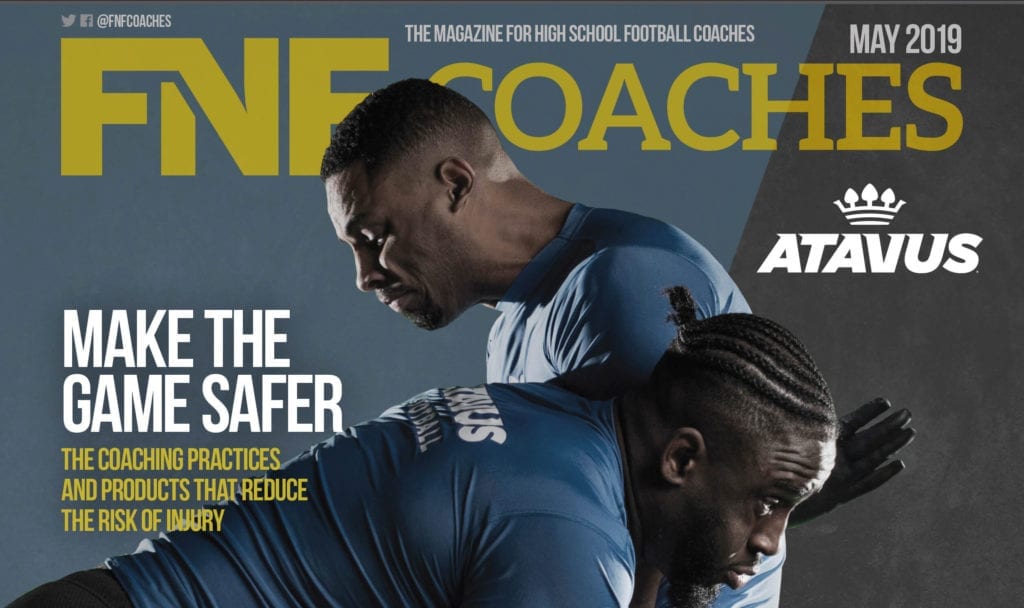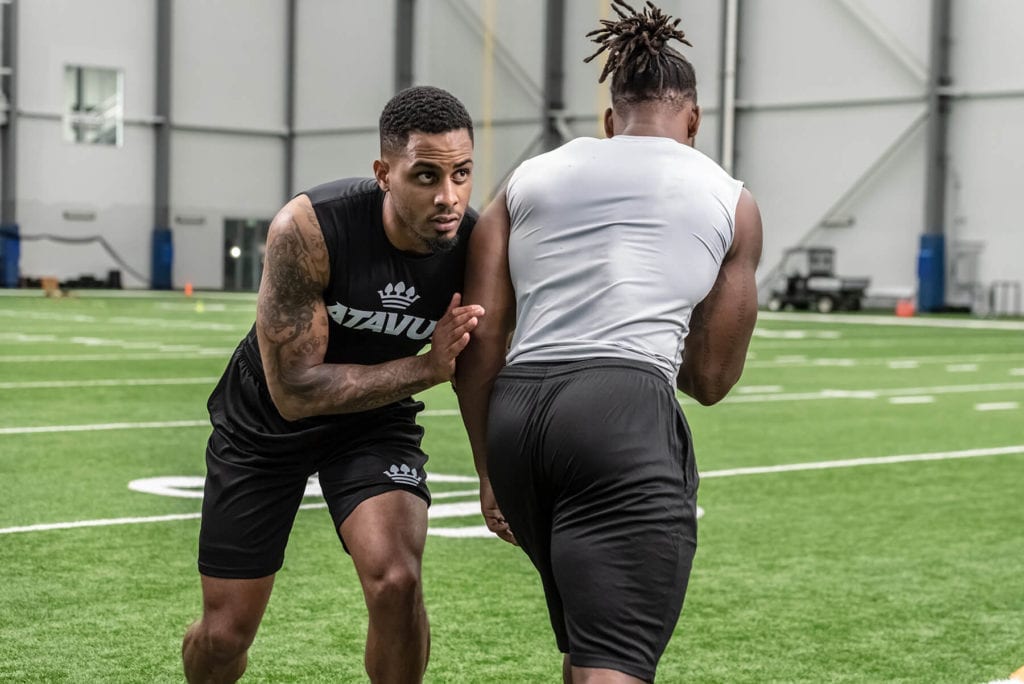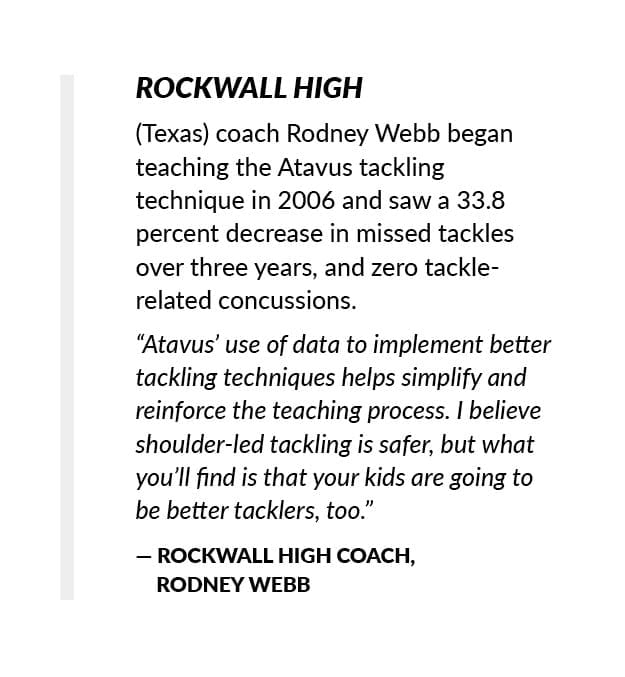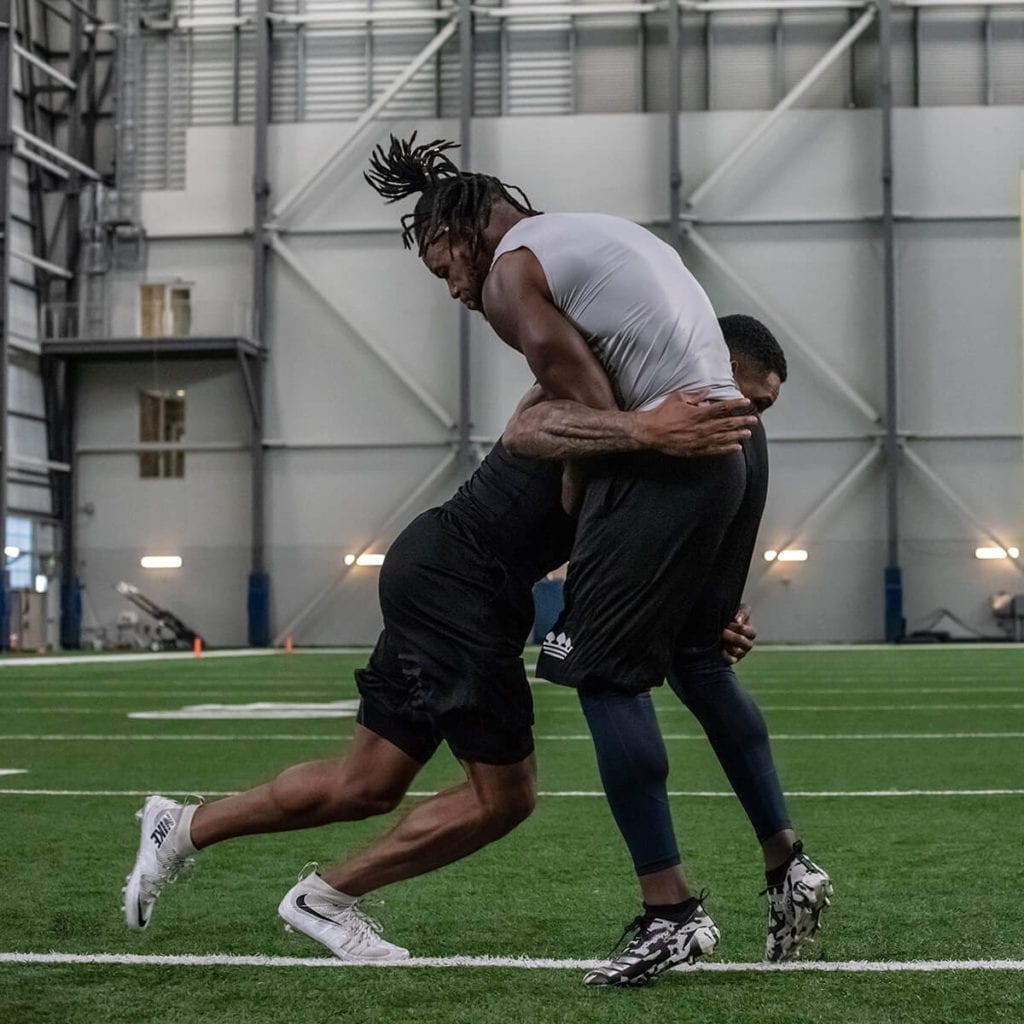| Regardless of the safety rating of a helmet or shoulder pad system, a player cannot rely solely on his equipment to prevent head injuries like concussions. While it is impossible for players to avoid contact on the football field, it is entirely possible to learn proper tackling technique to decrease the risk of injury. |

Dan Guttenplan, FNF Coaches, May. 7th 2019
Note: This article was originally published by FNF Coaches Magazine in their May 2019 edition, and written by FNF Coaches reporter Dan Guttenplan. You can find the article at https://fnfcoaches.com/digimag-...

When coaches in Texas noticed a trend of decreasing participation numbers in high school football, they decided to do something about it. The Texas High School Coaches Association attributed the drop in participation to the increased number of news stories highlighting concerns about the safety of the sport.
In the spring of 2018, the state’s governing body, the UIL Legislative Council, announced mandatory tackling certification for coaches. In cooperation with UIL, THSCA became the first state in the country to require all football coaches to successfully complete tackling certification.
With 23,000 junior high and high school coaches needing certification by August 1, 2019, the THSCA and UIL approached Atavus to help implement a certification program.
Atavus educates coaches to teach a safe, high performance tackling technique. Resources such as drill videos, practice plans, coaching tips, and practical, how-to advice are designed to give high school coaches the tools needed increase player safety and improve performance.

The UIL and THSCA aimed to launch a coaches’ certification program during the 2018 annual Coaching School conference in July of 2018. In order to ensure that all coaches would be certified by the August 2019 deadline, together, THSCA, UIL and Atavus decided to certify a hundreds of coaches at a time, while putting into place additional certification opportunities over the next 11 months leading up to the deadline.
“The folks with the THSCA and UIL launched a positive learning environment with as much face to face interaction as possible,” said Atavus Vice President of Operations Kerry Carter.
Each of the coaches that attended the Coaching School in San Antonio attended a 60- to 70-minute lecture followed by a 30-minute assessment. Atavus led four Coaching School sessions – two with more than 1,000 coaches each and two more with 500-plus each. To earn certification, coaches had to pass a written test.
More than 3,000 coaches earned certification through that first wave of Coaching School opportunities. Atavus also held certification sessions with coaches at the Texas state championship games in Dallas in December and four more in-person sessions in early 2019. In April of 2019, Atavus launched an online certification resource and has successfully certified thousands of Texas coaches since then.
Atavus teaches rugby-style tackling, emphasizing the shoulder – rather than the head – in bringing opposing players down. The company’s mission is to produce more effective tacklers by teaching defenders to square up before hitting a ball carrier and to use their shoulders and legs for leverage and power.

Pete Carroll, the coach of the Seattle Seahawks, has promoted “hawk tackling,” which borrows heavily from rugby. But Atavus, which works with coaches at Michigan State, Cincinnatti, Rutgers and other colleges, also uses video to analyze and rate tackles as well as identify additional drills to address deficiencies.
“A lot of coaches are aware of rugby-style tackling, which is shoulder-led, because of the success of the Seattle Seahawks and the ‘Hawk Tackle’ video,” Carter said. “We built on that. We gave it a little more structure more than just raising awareness. We want coaches to put in a system they can teach and evaluate, so they can start the cycle again.”
The Atavus model teaches pre-contact strategy as well as tackling technique. Coaches learn to teach players how to close space, the importance of strike timing, and how to be intentional about every aspect of practice and film analysis.
“We want coaches to speak the same language from coach to player,” Carter said. “Why do you want to do this? Here’s how to teach it. Here’s how to evaluate it. Here are the drills to put into practice. It’s a progression-based format and a tackling plan. It gives enough of a foundation to build on it.”
In addition to requiring tackling certification of coaches, the THSCA and UIL also are increasing the amount of time coaches can require players to practice during the spring. This also falls in line with the increased focused on player safety. The idea is that if the coaches have more time to teach proper tackling technique, players will be less likely to get injured.

“We think there should be a seasonal focus,” said Atavus VP of Football Rex Norris. “The more you get in-season, the more it gets positionspecific and football-specific. The thing we’re proud of is it helps coaches meet the requirements given the limits they’re being given. We want them to focus on the drills and skills needed to be a good tackler. Those skills can be taught without a ball, cones or pads.”
Some other state athletic associations are now looking at how the tackling-technique program is taking hold in Texas. Representatives from high school football coaches associations in Alabama, Georgia and Oklahoma, among others, are considering adopting a similar model. One of the obvious benefits of requiring certification
of coaches is that they will all be teaching it the same way – with the same verbiage and drills – in case players move from one program to another.
“With current momentum, we believe our approach will become the norm,” Carter said. “We want everyone using the same terms and taking it back to their own communities. We want it to be as immersive as possible, and we want to further empower coaches.”
Starting April 1, Atavus began offering online tackling-technique classes for coaches in Texas. So, coaches are no longer required to attend Coaching School to earn their certification.
“We’re also adding additional levels so that coaches can assess themselves and their ability to teach it,” Norris said. “It’s an element of maximizing practice time and player engagement and helping them with retention.
“The value in what we’re doing is not age-specific or skill-specific,” Norris said. “It’s about improving player safety and performance at all levels.”